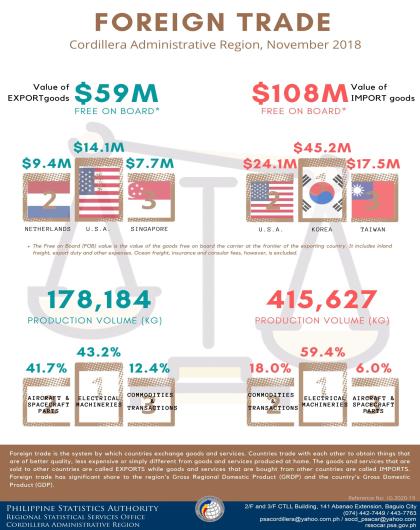Foreign Trade: Exports
- Foreign trade is the system by which countries exchange goods and services. Countries trade with each other to obtain things that are of better quality, less expensive or simply different from goods and services produced at home. The goods and services that are sold to other countries are called exports. Foreign trade has a significant share of the region’s Gross Regional Domestic Product and the country’s Gross Domestic Product.
- The Free On Board (FOB) value of export goods of the Cordillera Administrative Region (CAR) in March 2017 was recorded at $2,830,207. The volume of production showed a drastic decline compared to the same period last year with recorded value of $162,510,164. However, exports value posted an increase of 23.4 percent from the amount of $2,293,656 recorded last February 2017.
- In March 2017, the region’s total volume of production was recorded at 242 kilograms. Export volume drastically declined compared to the volume of 403,664,110 kilograms produced in same month last year, and decreased by 26.0 percent compared to the previous month.
Exports By Commodity
- Among the export commodities, natural or cultured pearls, precious or semi-precious stones, precious metals, metals clad with precious metals and articles thereof; imitation jewelry; and coin were largely produced for the First Quarter of 2017, accounting for 99.9 percent of export goods in February and 98.5 percent in March. These were valued at $2,291,869 and $2,789,043 in February and March 2017, respectively.
- Meanwhile, machinery and mechanical appliances, electrical equipment, parts thereof, sound recorders and reproducers, and parts and accessories of such articles shared 1.5 percent in the total exports of the region in March 2017. These were valued at $41,164 in export sales.
Country of Destination
- The region only exported to two countries in March 2017, namely, Hong Kong, and The Netherlands. Hong Kong had the biggest share of the region’s exports at
98.5 percent with a total value of $2,789,043. This was followed by The Netherlands at 1.5 percent or equivalent to $41,164 exports receipts.
VILLAFE P. ALIBUYOG
Regional Director
Technical Notes
-
Free on Board Value - is the value of the goods free on board the carrier at the frontier of the exporting country. It includes inland freight, export duty and other expenses. Ocean freight, insurance and consular fees, however, is excluded. These FOB values are obtained directly from the source documents. However, for cases where the FOB values declared in the source documents are not in US dollars, these values are converted to US dollars. The average US dollar rate for the month which is computed as the total daily rate of transactions divided by the number of working days in a month is used in converting FOB value to FOB US dollar value.
-
Country of Destination (Exports only) - it is the country of ultimate destination/shipment. It is not necessarily the country where the commodity/shipment is to be unloaded, as in the case of shipment unloaded from one ocean liner but is destined to a country that is landlocked. In which case, the country of destination is the landlocked country.
-
Country of Origin (Imports only) - it is the country where the commodity is mined, grown, or manufactured. Further processing or material added to it in another country must bring about a material transformation to render such country as the country of origin. The country of origin remains unchanged if the commodity is subjected to mere sorting, grading, cleaning, packaging or similar processing.
-
Exports - the goods and services that are sold to other countries.
-
Imports - the goods and services that a country buys from other countries.
-
Philippine Standard Commodity Classification - is used to classify the imported commodities at the most detailed level for statistical purposes.
-
Sources of Information - foreign trade statistics are compiled by the National Statistics Office, now the Philippine Statistics Authority, from copies of import and export documents submitted by importers and exporters or their authorized representatives to the Bureau of Customs as required by law.


